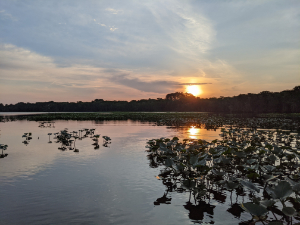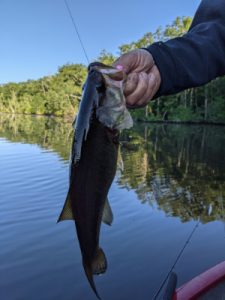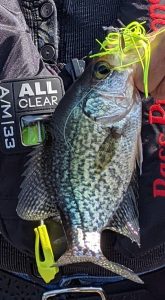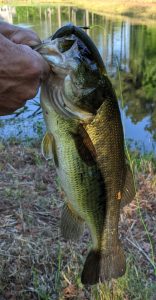 Another sweet Saturday on the Pocomoke River. We launched out of Snow Hill, MD and it was already rather warm when we left the dock at 5:30a. The sun was just peeking over the horizon. There was no wind and it was quite obvious that it was going to be a hot one!
Another sweet Saturday on the Pocomoke River. We launched out of Snow Hill, MD and it was already rather warm when we left the dock at 5:30a. The sun was just peeking over the horizon. There was no wind and it was quite obvious that it was going to be a hot one!
We ventured much further down river than we normally go and because it was low tide, we fished the outer edges of the lily pads and the banks. I caught two Crappie on a Strike King Mini-King Spinnerbait and one Large Mouth Bass on a Strike King Mini-King Spinnerbait. John caught one Crappie on Strike King Rage Swimmer and four Large Mouth Bass. Two bass were caught on a Gary Yamamoto 5” Green Pumpkin w/red Senko Wacky Worm, one bass on a “lizard” bait, and one bass on a Bigmouth Chatter Bait. He also caught at Blue Catfish on a Bigmouth Chatter Bait with a Strike King Rage Swimmer.
Blue Catfish are the largest species of North American catfish, reaching 65” in length and 150 pounds with the typical length being 25-46”. They can live for 20 years and tolerate brackish water, thus colonize along inland waterways of coastal regions. The largest recorded blue catfish caught was 143 pounds. Blue catfish are heavy bodied, blueish gray in color, and have a dorsal hump. They have 30-36 rays on their anal fin, barbels, a deeply forked tail, and a protruding upper jaw. Blue catfish are opportunistic predators and eat any species of fish they can catch, along with crayfish, freshwater mussels, frogs, and other readily available aquatic food sources. This fish is considered an invasive species in some areas, particularly the Chesapeake Bay.
 It got very hot around 10:00a and by 12:30p we were packing up. To cool off we took a ride down river and ended up in Pocomoke City. Pocomoke City, dubbed “the friendliest town on the Eastern Shore”, is located in Worcester County, MD. The city is regularly referred to by its inhabitants simply as Pocomoke. Beginning in the late seventeenth century, a small settlement called Stevens Landing grew at the ferry landing on the south bank of the Pocomoke River. The town was incorporated as Newtown in 1865, but was reincorporated in 1878 as Pocomoke City, after the American Indian name of the river, meaning “black water”. Stevens Landing, then Newtown, remained a modest river crossing until the construction through the town in the 1880s of the trunk railroad line (along the Delmarva Peninsula) from Wilmington, DE to Cape Charles, VA. The line eventually became part of the Pennsylvania Railroad. In addition to agriculture, lumber milling and shipbuilding, in the twentieth century factories making barrels and baskets for truck crops and canning of those crops aided in the town’s growth. In 1922 the business district of Pocomoke City was destroyed in a large fire, but downtown was quickly rebuilt. While truck farming declined in the 1900s, the poultry industry rose to take its place. Pocomoke City was named an All-American City by the National Municipal League.
It got very hot around 10:00a and by 12:30p we were packing up. To cool off we took a ride down river and ended up in Pocomoke City. Pocomoke City, dubbed “the friendliest town on the Eastern Shore”, is located in Worcester County, MD. The city is regularly referred to by its inhabitants simply as Pocomoke. Beginning in the late seventeenth century, a small settlement called Stevens Landing grew at the ferry landing on the south bank of the Pocomoke River. The town was incorporated as Newtown in 1865, but was reincorporated in 1878 as Pocomoke City, after the American Indian name of the river, meaning “black water”. Stevens Landing, then Newtown, remained a modest river crossing until the construction through the town in the 1880s of the trunk railroad line (along the Delmarva Peninsula) from Wilmington, DE to Cape Charles, VA. The line eventually became part of the Pennsylvania Railroad. In addition to agriculture, lumber milling and shipbuilding, in the twentieth century factories making barrels and baskets for truck crops and canning of those crops aided in the town’s growth. In 1922 the business district of Pocomoke City was destroyed in a large fire, but downtown was quickly rebuilt. While truck farming declined in the 1900s, the poultry industry rose to take its place. Pocomoke City was named an All-American City by the National Municipal League.
What a spectacular ride! The river was absolutely gorgeous! Seriously, if you are looking for a top-notch river on the Eastern Shore to fish, or to go out on for a pleasure ride, the Pocomoke River should definitely be on your bucket list. It is quiet, calm and full of wildlife. I found a place on VRBO that is right on the river where you could stay and launch from either Byrd Park in Snow Hill, Shad Landing, or Milburn Landing.
 moke River at 7:30a on Saturday and returned at 4:30p. We have been launching out of Shad Landing for several months. The parking lot is big which give me the advantage when putting the boat into the water, but maneuvering the boat back onto the trailer in the tight space provided is a bit of a challenge due to the tide.
moke River at 7:30a on Saturday and returned at 4:30p. We have been launching out of Shad Landing for several months. The parking lot is big which give me the advantage when putting the boat into the water, but maneuvering the boat back onto the trailer in the tight space provided is a bit of a challenge due to the tide. using a Booyah Micro Pond Magic Spinnerbait in Alpinewith a white paddle tail. This is a lure I use every time I fish. I caught my PB largemouth bass on this lure, in Lightning Bug, on this river at 5lb 2oz.
using a Booyah Micro Pond Magic Spinnerbait in Alpinewith a white paddle tail. This is a lure I use every time I fish. I caught my PB largemouth bass on this lure, in Lightning Bug, on this river at 5lb 2oz.
 John was given the opportunity to be an angler aboard the
John was given the opportunity to be an angler aboard the 







 We launched out of Byrd Park in Snow Hill, MD onto the Pocomoke River at 5:30a. As we passed the other boat ramp in the park, about 17+ bass boats were getting ready for a fishing tournament.
We launched out of Byrd Park in Snow Hill, MD onto the Pocomoke River at 5:30a. As we passed the other boat ramp in the park, about 17+ bass boats were getting ready for a fishing tournament. One tournament boat actually stopped 25-feet from our boat and started fishing. Literally my line and his line would touch if thrown in the same direction at the same time. I was perplexed by this interaction. Surely there must to be some kind of fishing etiquette.
One tournament boat actually stopped 25-feet from our boat and started fishing. Literally my line and his line would touch if thrown in the same direction at the same time. I was perplexed by this interaction. Surely there must to be some kind of fishing etiquette. As we were approaching a bird landing box, I switched from my buzz bait to a worm. I tossed the worm at the pole the box was attached to and it landed perfectly. That’s when God intervened and gave me this one. A Largemouth Bass took the bait on the drop and I reeled it into the boat. Oh, my! I have to say that if you were within 25-feet of our boat you couldn’t deny the excitement.
As we were approaching a bird landing box, I switched from my buzz bait to a worm. I tossed the worm at the pole the box was attached to and it landed perfectly. That’s when God intervened and gave me this one. A Largemouth Bass took the bait on the drop and I reeled it into the boat. Oh, my! I have to say that if you were within 25-feet of our boat you couldn’t deny the excitement. The air was chilly this morning when we left the Snow Hill boat ramp at 5:00a to go down river on the Pocomoke. The sun rose behind wisps of clouds, but it was nonetheless beautiful. The water was still for now.
The air was chilly this morning when we left the Snow Hill boat ramp at 5:00a to go down river on the Pocomoke. The sun rose behind wisps of clouds, but it was nonetheless beautiful. The water was still for now. After casting several times with a Gary Yamamoto Pumpkin Green w/red Wacky Worm John hooked something that took the worm and ran with it. He said it didn’t feel like a bass and as he was reeling it in he realized it was quite big. As it got closer to the boat we got a short glimpse of it and thought it might be a catfish. Then it charged and went under the boat. John wrangled it out from under the boat and upon a second inspection we realized it was a SNAKEHEAD! Our first Snakehead! I grabbed the net. Every time I got close to it with the net it would thrash around. I scooped and scooped and finally connected and got it up and into the boat. Wow, what an adrenaline rush. What fun! It was at least ten pounds and so slimy. John couldn’t believe he hooked snakehead with a worm. Such excitement!
After casting several times with a Gary Yamamoto Pumpkin Green w/red Wacky Worm John hooked something that took the worm and ran with it. He said it didn’t feel like a bass and as he was reeling it in he realized it was quite big. As it got closer to the boat we got a short glimpse of it and thought it might be a catfish. Then it charged and went under the boat. John wrangled it out from under the boat and upon a second inspection we realized it was a SNAKEHEAD! Our first Snakehead! I grabbed the net. Every time I got close to it with the net it would thrash around. I scooped and scooped and finally connected and got it up and into the boat. Wow, what an adrenaline rush. What fun! It was at least ten pounds and so slimy. John couldn’t believe he hooked snakehead with a worm. Such excitement! We left the Snow Hill boat ramp around 5:00a as the high tide was coming in. The Pocomoke River was like glass and the sunrise was beautiful as usual.
We left the Snow Hill boat ramp around 5:00a as the high tide was coming in. The Pocomoke River was like glass and the sunrise was beautiful as usual. One our way back to the dock we went a little further up river and saw the river boat that Snow Hill acquired from Havre de Grace. The name of the boat is the Black-Eyed Susan. It is a 111-foot paddlewheel driven riverboat that was built in the late 1980s. For many years it cruised around southern states and was eventually moved to Baltimore in 2000. From 2000 to 2016 you may have spotted this paddle boat around the Inner Harbor. In the spring of 2017, it moved to Havre de Grace where you could see it on the Susquehanna River. In late 2020 Snow Hill secured the boat and after some cosmetic improvements it is now docked at the Port of Snow Hill. Soon you will be able to see it on the Pocomoke River!
One our way back to the dock we went a little further up river and saw the river boat that Snow Hill acquired from Havre de Grace. The name of the boat is the Black-Eyed Susan. It is a 111-foot paddlewheel driven riverboat that was built in the late 1980s. For many years it cruised around southern states and was eventually moved to Baltimore in 2000. From 2000 to 2016 you may have spotted this paddle boat around the Inner Harbor. In the spring of 2017, it moved to Havre de Grace where you could see it on the Susquehanna River. In late 2020 Snow Hill secured the boat and after some cosmetic improvements it is now docked at the Port of Snow Hill. Soon you will be able to see it on the Pocomoke River!






 When we arrived at the boat ramp in Snow Hill, MD at 5:30a to fish the Pocomoke River the sun was just starting to rise and the fog rolling off the water looked like smoke on the water. The high tide was higher than normal due to the rain we had gotten for several days prior. As usual the sunrise was beautiful. I am grateful that we get to witness these amazing sunrises.
When we arrived at the boat ramp in Snow Hill, MD at 5:30a to fish the Pocomoke River the sun was just starting to rise and the fog rolling off the water looked like smoke on the water. The high tide was higher than normal due to the rain we had gotten for several days prior. As usual the sunrise was beautiful. I am grateful that we get to witness these amazing sunrises.






 As we headed down river toward Upper Ferry we passed a river cruise ship docked at the Port of Salisbury. This river was wide and open. It was more grasses than banks and the lily pads weren’t as abundant. The houses that bordered the river were gorgeous.
As we headed down river toward Upper Ferry we passed a river cruise ship docked at the Port of Salisbury. This river was wide and open. It was more grasses than banks and the lily pads weren’t as abundant. The houses that bordered the river were gorgeous. The
The  We went a little further and turned around at the
We went a little further and turned around at the 



 Another sweet Saturday on the Pocomoke River. We launched out of Snow Hill, MD and it was already rather warm when we left the dock at 5:30a. The sun was just peeking over the horizon. There was no wind and it was quite obvious that it was going to be a hot one!
Another sweet Saturday on the Pocomoke River. We launched out of Snow Hill, MD and it was already rather warm when we left the dock at 5:30a. The sun was just peeking over the horizon. There was no wind and it was quite obvious that it was going to be a hot one! It got very hot around 10:00a and by 12:30p we were packing up. To cool off we took a ride down river and ended up in Pocomoke City. Pocomoke City, dubbed “the friendliest town on the Eastern Shore”, is located in Worcester County, MD. The city is regularly referred to by its inhabitants simply as Pocomoke. Beginning in the late seventeenth century, a small settlement called Stevens Landing grew at the ferry landing on the south bank of the Pocomoke River. The town was incorporated as Newtown in 1865, but was reincorporated in 1878 as Pocomoke City, after the American Indian name of the river, meaning “black water”. Stevens Landing, then Newtown, remained a modest river crossing until the construction through the town in the 1880s of the trunk railroad line (along the Delmarva Peninsula) from Wilmington, DE to Cape Charles, VA. The line eventually became part of the Pennsylvania Railroad. In addition to agriculture, lumber milling and shipbuilding, in the twentieth century factories making barrels and baskets for truck crops and canning of those crops aided in the town’s growth. In 1922 the business district of Pocomoke City was destroyed in a large fire, but downtown was quickly rebuilt. While truck farming declined in the 1900s, the poultry industry rose to take its place. Pocomoke City was named an All-American City by the National Municipal League.
It got very hot around 10:00a and by 12:30p we were packing up. To cool off we took a ride down river and ended up in Pocomoke City. Pocomoke City, dubbed “the friendliest town on the Eastern Shore”, is located in Worcester County, MD. The city is regularly referred to by its inhabitants simply as Pocomoke. Beginning in the late seventeenth century, a small settlement called Stevens Landing grew at the ferry landing on the south bank of the Pocomoke River. The town was incorporated as Newtown in 1865, but was reincorporated in 1878 as Pocomoke City, after the American Indian name of the river, meaning “black water”. Stevens Landing, then Newtown, remained a modest river crossing until the construction through the town in the 1880s of the trunk railroad line (along the Delmarva Peninsula) from Wilmington, DE to Cape Charles, VA. The line eventually became part of the Pennsylvania Railroad. In addition to agriculture, lumber milling and shipbuilding, in the twentieth century factories making barrels and baskets for truck crops and canning of those crops aided in the town’s growth. In 1922 the business district of Pocomoke City was destroyed in a large fire, but downtown was quickly rebuilt. While truck farming declined in the 1900s, the poultry industry rose to take its place. Pocomoke City was named an All-American City by the National Municipal League.